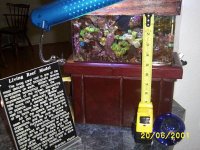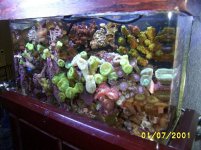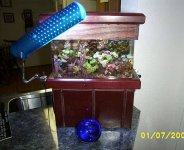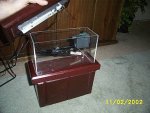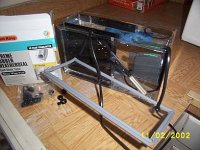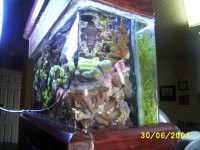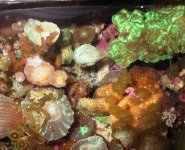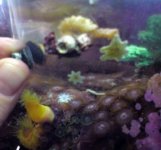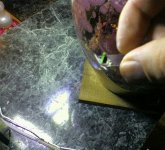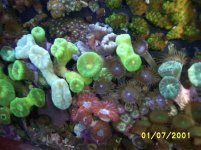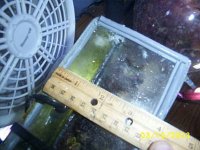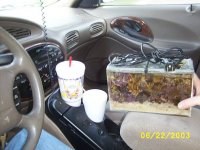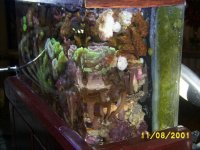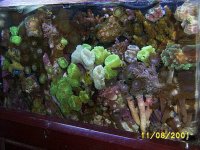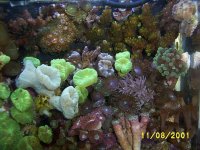This particular reef is an improvement over the last two designs in that the lid can now be removed over and over without affecting the true sealing of the system. This aquarium is about 4 weeks old, and has not been topped off, however I have done several 90% water changes to battle the typical cycling trends of diatoms and various unwanted populations.
I improved the sealing technique by using weatherstripping as in the first two reef models, but this one had a seal of silicone beaded thickly around the tank and was allowed to dry all the way around the lid (between the weatherstripping contact areas) securing it to the tank. After curing, I used a razor to cut a single pass around the lid, freeing it from the tank, with a perfect seal cut in place that only needs top weight to press it into place (the canopy and fan weight is sufficient) when the lid is re-installed. Again the power cords to the pump and heater were cut and ran through black grommets in two holes of the fitted glass lid, to prevent evaporation through the cable-pass channels.
The other systems had an eventual breakdown in the seals due to repeated stress, they wouldn't hold the true alignment and did let water slip out over time...these seals are reinforced better with heavy silicone, hopefully that will hold longer without maintenance. This reef has a small desk fan on it during 'lights on' and I work hard to keep my max internal room temp at 74 degrees (with my ac system)--that is the tradeoff in keeping a tiny sealed reef. It is handy not to have to topoff, but the temperature max of the room is lowered significantly if you want to keep enough light on the system to grow SPS. I depend solely on my home ac to control all temperature variants, the little 6" heater (Tronic brand) does the job fom inside the reef when things are cool in the fall and winter.
So far I've invested about $350-400 into the coral frags, buying only the best lot from the local pet shops, when they have small frags available. Twice I have purchased some very expensive acro bushes to install by clipping all the growth branches off the colony. The round nub of acro leftover is given back to a fellow aquarist to regrow sometime in the distant future.
stocked with: Acropora elec. green and red varieties, small orange ricordia (dime-size) clavularia, briareum (small, isolated patch->it took over my last tank), several zoanthid varieties, two blastomussa varieties, three kinds of caulastrea (Candy Coral) which comprise the focal point of the horizontal line aquascape, two tiny kenya tree frags, 1 isolated blue and red mushroom, white pumping xenia, brown button polyps (palythoa) small yellow montipora frag, tiny porites mound (eraser-size), a few heads of anthelia, yellow polyps (parazoanthus a.)
I used tweezers, surgical tools and automotive super glue gel to hold it all in place. The lighting is one 13w 50/50 above, one from the side and a 7watt 6500 K for the rear refugium lighting (constant-on). This refugium is growing well in the rear housing, fills it completely every month or so in the other models.
I improved the sealing technique by using weatherstripping as in the first two reef models, but this one had a seal of silicone beaded thickly around the tank and was allowed to dry all the way around the lid (between the weatherstripping contact areas) securing it to the tank. After curing, I used a razor to cut a single pass around the lid, freeing it from the tank, with a perfect seal cut in place that only needs top weight to press it into place (the canopy and fan weight is sufficient) when the lid is re-installed. Again the power cords to the pump and heater were cut and ran through black grommets in two holes of the fitted glass lid, to prevent evaporation through the cable-pass channels.
The other systems had an eventual breakdown in the seals due to repeated stress, they wouldn't hold the true alignment and did let water slip out over time...these seals are reinforced better with heavy silicone, hopefully that will hold longer without maintenance. This reef has a small desk fan on it during 'lights on' and I work hard to keep my max internal room temp at 74 degrees (with my ac system)--that is the tradeoff in keeping a tiny sealed reef. It is handy not to have to topoff, but the temperature max of the room is lowered significantly if you want to keep enough light on the system to grow SPS. I depend solely on my home ac to control all temperature variants, the little 6" heater (Tronic brand) does the job fom inside the reef when things are cool in the fall and winter.
So far I've invested about $350-400 into the coral frags, buying only the best lot from the local pet shops, when they have small frags available. Twice I have purchased some very expensive acro bushes to install by clipping all the growth branches off the colony. The round nub of acro leftover is given back to a fellow aquarist to regrow sometime in the distant future.
stocked with: Acropora elec. green and red varieties, small orange ricordia (dime-size) clavularia, briareum (small, isolated patch->it took over my last tank), several zoanthid varieties, two blastomussa varieties, three kinds of caulastrea (Candy Coral) which comprise the focal point of the horizontal line aquascape, two tiny kenya tree frags, 1 isolated blue and red mushroom, white pumping xenia, brown button polyps (palythoa) small yellow montipora frag, tiny porites mound (eraser-size), a few heads of anthelia, yellow polyps (parazoanthus a.)
I used tweezers, surgical tools and automotive super glue gel to hold it all in place. The lighting is one 13w 50/50 above, one from the side and a 7watt 6500 K for the rear refugium lighting (constant-on). This refugium is growing well in the rear housing, fills it completely every month or so in the other models.




